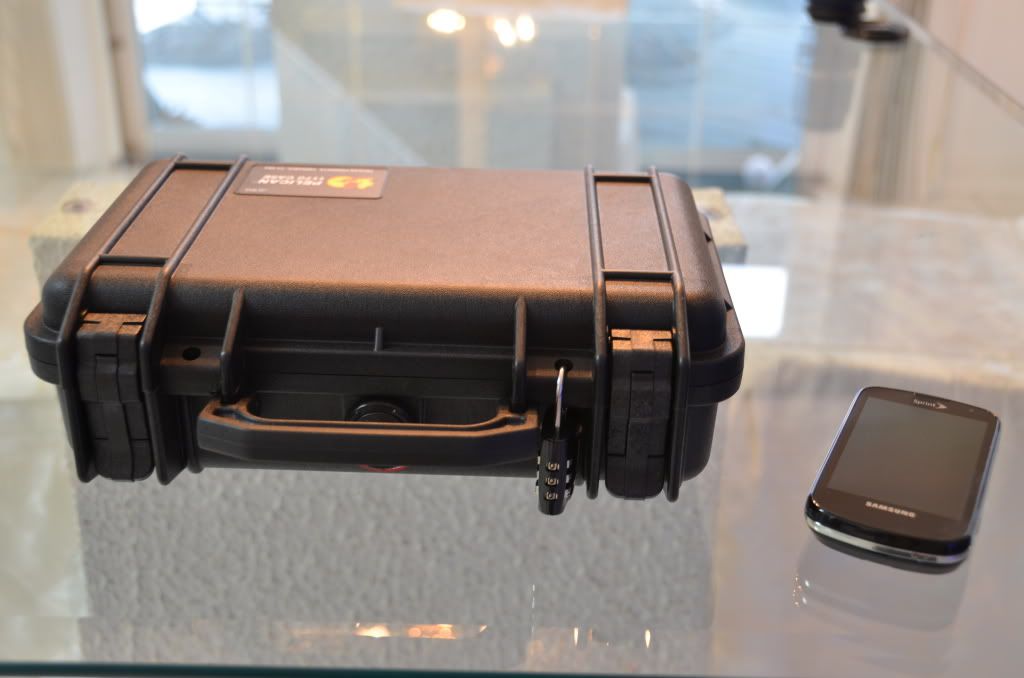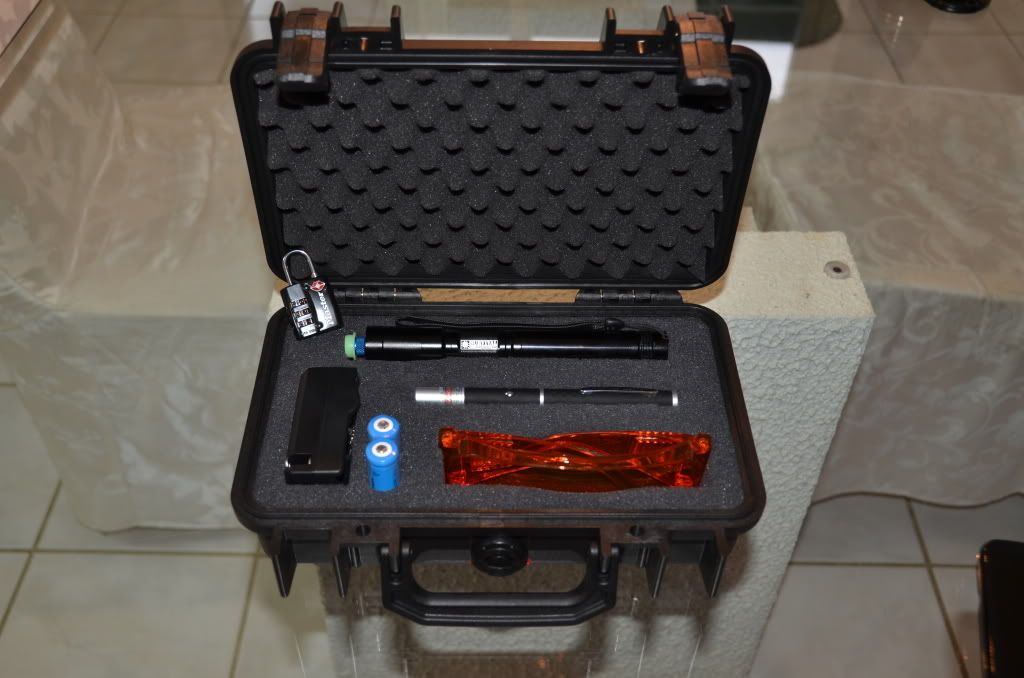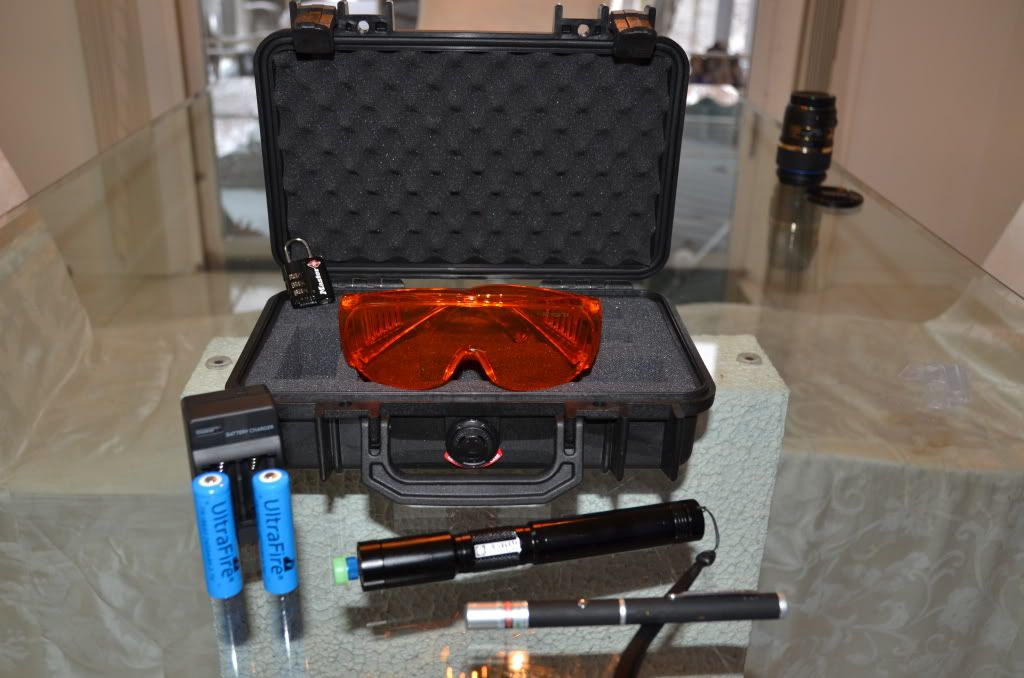I received and assembled the laser and waited for the batteries to charge (about 5 hours.) This model is 1800mW and generates a 445nm beam (beam is blue in color.) It has a 60 seconds maximum duty cycle and then requires a 120 second cooling time. I purchased a Pelican case and lock to prevent any unintentional access.
The second laser shown is a lower output 30mW laser with a 532nm beam (green.) This will be affixed to the main laser used for targeting and to test if any reflections will occur. The spectrum is important as the safety glasses block virtually all light in the 190-445nm range, making it almost impossible to see any reflections from the main laser. The green color beam of the targeting laser is easily viewable with the safety glasses on. Targeting with the low power laser is also important due to how quickly the main laser damages anything it touches. You would not want to hit a prized coral for even a second.
I've only had a time to conduct a few tests as I want to complete fabricating a shield to protect the livestock before continuing. Also, more time will be needed to fully determine the impact and to see if anything re-grows – but here is what I've observed so far…
Safety observations…This thing is scary-powerful. You have to be very careful.
- An 1800mW laser beam is both terrifying and amazing. I used a cardboard box to initially set the lens focus. The very instant the end point was focused, it began cutting through the box. In just a couple seconds the beam had completely burned through the cardboard.
- The Eagle Pair safety glasses do a great job of blocking light in the 190-540nm spectrum – All that is visible is an orange, pinpoint glow at the beam endpoint. Reflections are very difficult to see. This poses an additional risk and underscores the importance of first targeting with a low power laser (in a spectrum that can be seen while wearing the safety glasses) to test for dangerous reflections. It's also important to note that the glasses are designed to prevent against stray, reflected laser light – they are not designed to protect against a beam hitting you directly in the eye. After seeing the power of this, I shudder to think what would happen to your eye.
- Caution is advised is determining the angle at which you lase through the glass or acrylic. You have to be careful not to use the laser perfectly perpendicular to the glass/acrylic as unseen reflections will result in lasing your hand. Even the reflection is quite painful and feels like being stuck with a thousand needles. I now wear a long sleeve shirt and nitrile gloves when using the laser as another precaution.
- I have real concerns about any fish viewing the beam endpoint. Thus far, I've only used the laser in areas where no fish were present until I can fabricate a shield. I would NOT use this without a method to prevent livestock from viewing the beam end-point.
- Even after extended laser sessions with the beam in the same spot, I detected no temperature increase in either glass or acrylic. I made sure all panes were clean. As far as impact to the tank itself - I believe it to be completely safe for use from outside an aquarium.
- I've found it to be more effective if all water movement in the tank is stopped during laser sessions. The minimizes cooling keeps the targets still.
- I've ordered a second pair of safety glasses (~$50) to enable an observer to photograph and video the process. Without eye protection, I would not allow anyone (or any pet) anywhere near the room with an active laser.
Early Results
Wow… there is no doubt in my mind that this is an effective method to kill virtually ANYTHING in an aquarium. The immediate results vary based on the type of target. So far I've tried the following,
- Aiptasia – Highly effective. Within seconds, you can clearly hear a “sizzling” sound as they literally begin to boil – often following by a “pop” as they explode. They try and retreat as soon as the laser hits them. Assuming you have a clear shot at the hole – this only increased the lasers effectiveness as you're able to focus all the energy in a single spot (as opposed to lasing the fully opened Aiptasia. I will be very surprised if any of the Aiptasia targeted return. Time to total kill - <10 seconds.
- Green Star Polyps – Highly effective. Within in seconds they are toast. They burn very quickly.
- Xenia – Effective. Killing Xenia does to take longer than the Aiptasia – I'd estimate about 30 seconds. This may be due to their lighter color. It seems best to focus on the base of the polyp often resulting in a popping noise. Time will tell if they return.
- Mojano – I dont' have any Mojano in any of my tanks, but I see no reason why the results would be much different. It may take slightly longer to kill larger specimens, but the end result should be the same…death by LASER.
- Valonia – Too soon to tell. The laser quickly cuts directly though both walls of any Valonia bubble but more time will be needed to see if this actually kills the bubble.
- Miscellaneous Algaes – Too soon to tell. When lasered, virtually everything living begins to pop and smoke. It's amazing how clearly you can hear the sizzling sound. It would take a lot of time to destroy large patches of algae, but I believe it is possible.
- Cyano – Highly Effective. A quick pass makes Cyano disappear. It works although I think there are more effective means to combat Cyano.
I'll follow up with before/after photos and video once I receive a second pair of safety glasses for an observer to film and with updates as to if any of the targeted pests regrew.
[Timezone Detection]
Create Account - Join in Seconds!
-
11-30-2011, 09:20 AM #21

Last edited by CalmSeasQuest; 12-02-2011 at 10:54 AM. Reason: inserted initial review
The reasonable man adapts himself to the world; the unreasonable one persists in trying to adapt the world to himself. Therefore, all progress depends on the unreasonable man. - George Bernard Shaw
-
11-30-2011, 01:17 PM #22

All drama aside, I would love to read more info on the laser! Please continue!
I originally read some about this topic over on RC but really stopped researching it much due to all of the safety concerns. It sounds like you're making a lot of progress on ideas to combat those issues. I noticed that you mentioned that the laser has the ability to use a low powered laser to "test" for reflection issues. The reflection issue is the biggest deal for me. Not just for the tank inhabitants but for other inhabitants in the room (my husband, dogs, etc.) Does the powerful laser not actually display until the low powered display determines its safe? Is this pretty fool proof?
-
12-02-2011, 10:49 AM #23

Your concern is valid.
Because the safety glasses block almost all of the 445nm light, it's difficult if not impossible to see all the reflections from the main laser (hence the importance of the targeting laser.) In the cases where I inadvertently lased my hand, I was not able to see the reflection, but I certainly felt the pain.
I'm creating a fixture to attach the targeting laser directly to the main laser so that it can be adjusted to set the correct convergence based on the distance from the target.
This is definitely not fool proof. Despite what I thought were adequate precautions, I still managed to "sting" myself a couple times. I hadn't accounted for the fact I would not be able to see all the reflections.
I absolutely would not allow anyone or any pet anywhere near a room that had an active laser without eye protection.The reasonable man adapts himself to the world; the unreasonable one persists in trying to adapt the world to himself. Therefore, all progress depends on the unreasonable man. - George Bernard Shaw
-
12-02-2011, 12:42 PM #24

Jim, you stole my posting! I was going to suggest trained Blennies that could be equipped with laser weaponry mounted on their backs. Dr. Evil would approve...
What's to stop a laser powerful enough to cut through calcareous skeleton from cutting through the bottom of your tank? I have seen laser cutting equipment used to replace metal stamping equipment... and they always come WITH a program designed to cut a new work table - because you are always replacing the destroyed ones. Granted "hot enough to boil a monkey's bum" would kill the aiptasia, and not actually CUT through anything. But,...
-
12-02-2011, 10:18 PM #25

If you need some mojanos to test on, let me know.....
I have been battling the same mother group for over 10 years! So far I keep them under control but never fully eradicate them. I have at least 3 at all times.
-
12-03-2011, 01:48 PM #26

Thanks Chris - I've had many offer up their tanks containing Aiptasia and Mojanos for testing.
Early results indicate they won't stand a chance It will be a while though - I still have lots of testing to do before I would consider recommending this for anyone else's tank.
The reasonable man adapts himself to the world; the unreasonable one persists in trying to adapt the world to himself. Therefore, all progress depends on the unreasonable man. - George Bernard Shaw
It will be a while though - I still have lots of testing to do before I would consider recommending this for anyone else's tank.
The reasonable man adapts himself to the world; the unreasonable one persists in trying to adapt the world to himself. Therefore, all progress depends on the unreasonable man. - George Bernard Shaw
-
12-03-2011, 01:57 PM #27

I took some time to think through what types of general hazards and precautions might apply to anyone considering the use of lasers in aquaria. This is just a rough, first draft that will hopefully serve as a springboard for more discussion and refinement of a set of "best practices"
I also feel a disclaimer is appropriate...
Lasers are dangerous. I am not a laser technician, scientist, specialist or expert. I have no formal education in the use of lasers. I am simply a marine hobbyist researching the use of lasers in aquaria. There is no guarantee as to accuracy. These are not instructions or guidelines, but rather talking points intended to spark further discussion on the subject. Use this information at your own risk.
This is a work in progress - Please feel free to comment or add anything you beleive should also be included...
Best practices for the use of lasers in aquaria (first draft)
Secure the Area
The lase area should be closed off from any transient traffic to prevent someone from unknowingly entering the area without appropriate eye protection. Any doors should be closed and locked. Any windows should be covered or blinds closed to prevent the escape of reflected laser energy. Only the laser operator and those required in the process should be allowed in the area. All pets should be removed from the area and prevented for reentering while the laser is in use.
Protective Gear
A high power laser beam striking your eye, or the eye of an observer can result in instant and permanent blindness. Even viewing the beam endpoint without eye protection will cause eye damage. The user and everyone within the viewing or potential reflection areas must be equipped with appropriate eye protection specifically designed for the wavelength laser being used. Sunglasses do not protect against laser light. Laser eye protection is designed to protect against unintentional reflections and endpoint viewing. It is not designed to protect from a laser beam being directed toward the eye. Never look directly at a laser beam or allow it to directly strike your eye. Long sleeves and Nitrile gloves offer an additional layer of protection for the operator.
Identify and Eliminate Reflection Hazards
Using high power lasers in glass and acrylic tanks is virtually guaranteed to create potentially hazardous beam reflections. These beam reflections can cause serious injury. This danger is amplified by the fact that use of the appropriate safety goggles will prevent you from seeing most beam reflections. Positioning the laser at right angles (directly perpendicular) to the tank glass or acrylic should be avoided as unseen laser energy will be reflected directly toward the user. Burns to exposed tissue can occur within seconds.To prevent injury, a low power targeting laser (such as a laser pointer) in a different spectrum that can be seen when using the safety goggles should be utilized to identify any reflections before firing the high power laser.
Identify Backstops
The laser beam will penetrate clean glass or acrylic with virtually no heat being transmitted to the tank material. The beam will quickly (almost instantly) pierce though the targeted item and impact anything behind it. Extreme caution must be exercised to prevent injury to any livestock located behind the targeted item. Painted or dark glass or acrylic surfaces may become heated during lasing.
Reduce Water Flow
Pumps should be turned off during lasering. This limits the cooling effect of water passing over the target thereby increasing the effectiveness of the laser and reducing the firing duration required to achieve the intended results. It also simplifies targeting as the intended pest is motionless.
Protecting Tank Inhabitants
Failure to protect tank inhabitants from repeated viewing the beam endpoint will likely result in blindness to your livestock. Ideally, all livestock should be removed and held in quarantine in a tank protected (covered) from stray laser light until laser treatment is completed. Alternative methods(s) to protect livestock from encountering the beam or end-point include,
- Physical Barriers - Use of physical barriers to prevent inhabitants from accessing an area being lased and to prevent any laser energy (beam pass-through or reflections) from entering any areas containing livestock.
- Endpoint Shield - If physically blocking off the area being lased is impractical due to tank features, an end-point shield should be used to prevent inhabitants from viewing the end-beam. In this case, extreme diligence is required to extinguish the beam should any inhabitants approach. This is likely, due to curiosity over the sizzling sound created by the operating laser. The endpoint shield can be created by simply as a short section of opaque acrylic (such as painted or frosted.) PVC should not be used as it emits toxins when heated.
Potential Impact to Water Quality
Use of a lasers to eradicate certain marine pests may result in the release of undetermined levels of toxins into the water column. It is believed that the intense heat may break down some of the compounds (such as Palytoxins.) Depending on the type and number of pests being destroyed and the size of the tank, the user should be prepared to use fresh carbon and or execute a water change to reduce any toxins produced.
Securing the Laser When Not in Use
When not in use the laser should be treated and stored as a firearm. When not is use it should be secured in a lockable case with batteries removed. The locked case should be stored out of the reach of children.
Thanks to those that have already provided comments and additonal items to include - It's rough, but it's a start.The reasonable man adapts himself to the world; the unreasonable one persists in trying to adapt the world to himself. Therefore, all progress depends on the unreasonable man. - George Bernard Shaw Sir Patrick liked this post
Sir Patrick liked this post
- Physical Barriers - Use of physical barriers to prevent inhabitants from accessing an area being lased and to prevent any laser energy (beam pass-through or reflections) from entering any areas containing livestock.
-
12-06-2011, 09:03 AM #28
 Advanced Aquarist Article
Advanced Aquarist Article
The use of Lasers by Marine Aquarists was just featured in Advanced Aquarist...
The reasonable man adapts himself to the world; the unreasonable one persists in trying to adapt the world to himself. Therefore, all progress depends on the unreasonable man. - George Bernard Shaw
-
12-06-2011, 09:19 AM #29

Congrats on the feature!
-
12-06-2011, 03:10 PM #30



- Join Date
- Oct 2009
- Location
- Ann Arbor
- Posts
- 381

CSQ Laser tattoo removal service he is not telling us about lol. Looks like a cool project will be neat to see how it works!
Paulo
Similar Topics
-
Algae & Pests Pest control
By MizTanks in forum BasicsReplies: 19Last Post: 08-19-2013, 03:48 PM





 Reply With Quote
Reply With Quote




